2023 TOYOTA YARIS CROSS tire pressure
[x] Cancel search: tire pressurePage 441 of 698
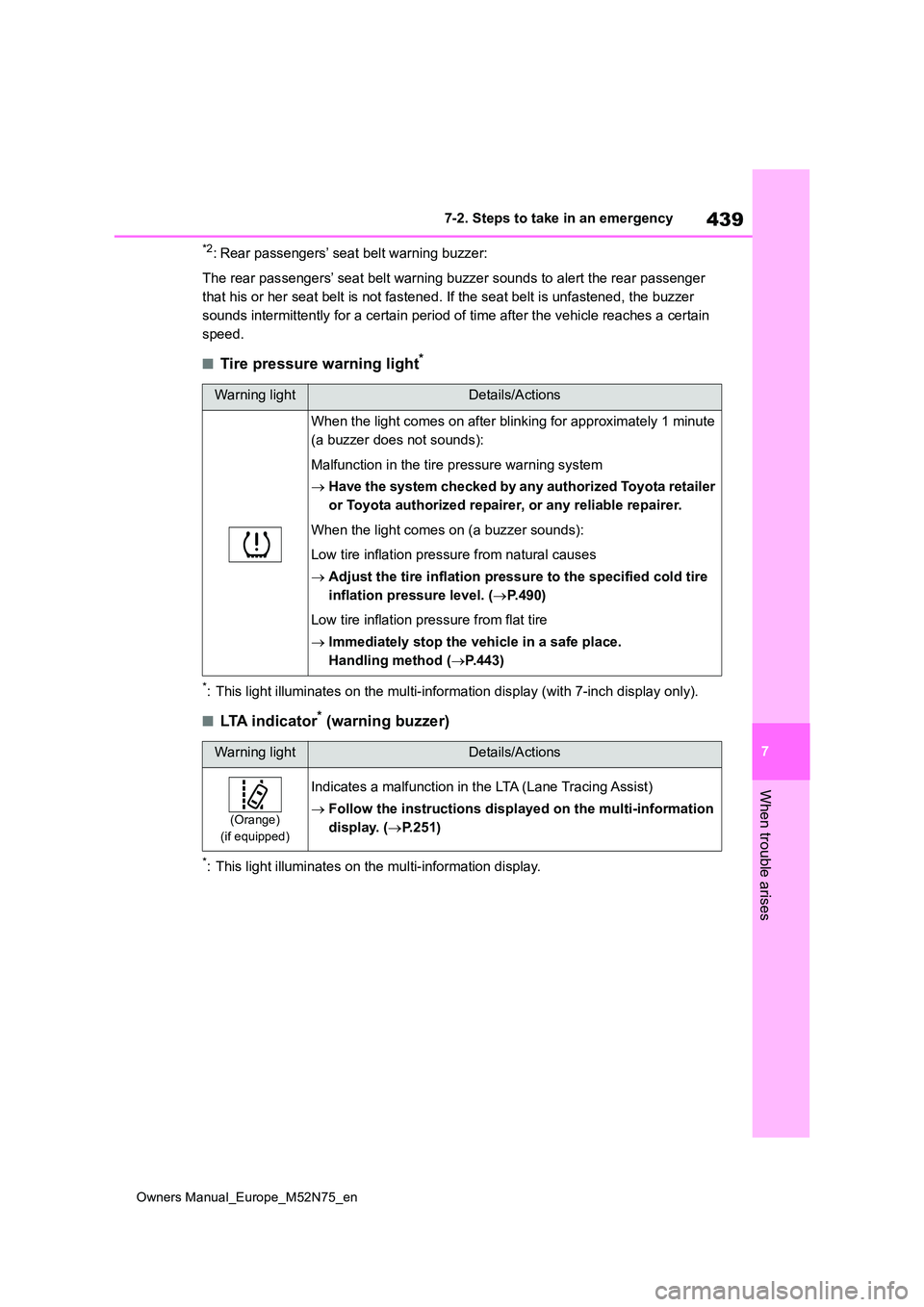
439
7
Owners Manual_Europe_M52N75_en
7-2. Steps to take in an emergency
When trouble arises
*2: Rear passengers’ seat belt warning buzzer:
The rear passengers’ seat belt warning buzzer sounds to alert t he rear passenger
that his or her seat belt is not fastened. If the seat belt is unfastened, the buzzer
sounds intermittently for a certain period of time after the ve hicle reaches a certain
speed.
■Tire pressure warning light*
*: This light illuminates on the multi-information display (with 7-inch display only).
■LTA indicator* (warning buzzer)
*: This light illuminates on the multi-information display.
Warning lightDetails/Actions
When the light comes on after blinking for approximately 1 minute
(a buzzer does not sounds):
Malfunction in the tire pressure warning system
Have the system checked by any authorized Toyota retailer
or Toyota authorized repairer, or any reliable repairer.
When the light comes on (a buzzer sounds):
Low tire inflation pressure from natural causes
Adjust the tire inflation pressure to the specified cold tire
inflation pressure level. ( P.490)
Low tire inflation pressure from flat tire
Immediately stop the vehicle in a safe place.
Handling method ( P.443)
Warning lightDetails/Actions
(Orange)
(if equipped)
Indicates a malfunction in the LTA (Lane Tracing Assist)
Follow the instructions displayed on the multi-information
display. ( P.251)
Page 445 of 698
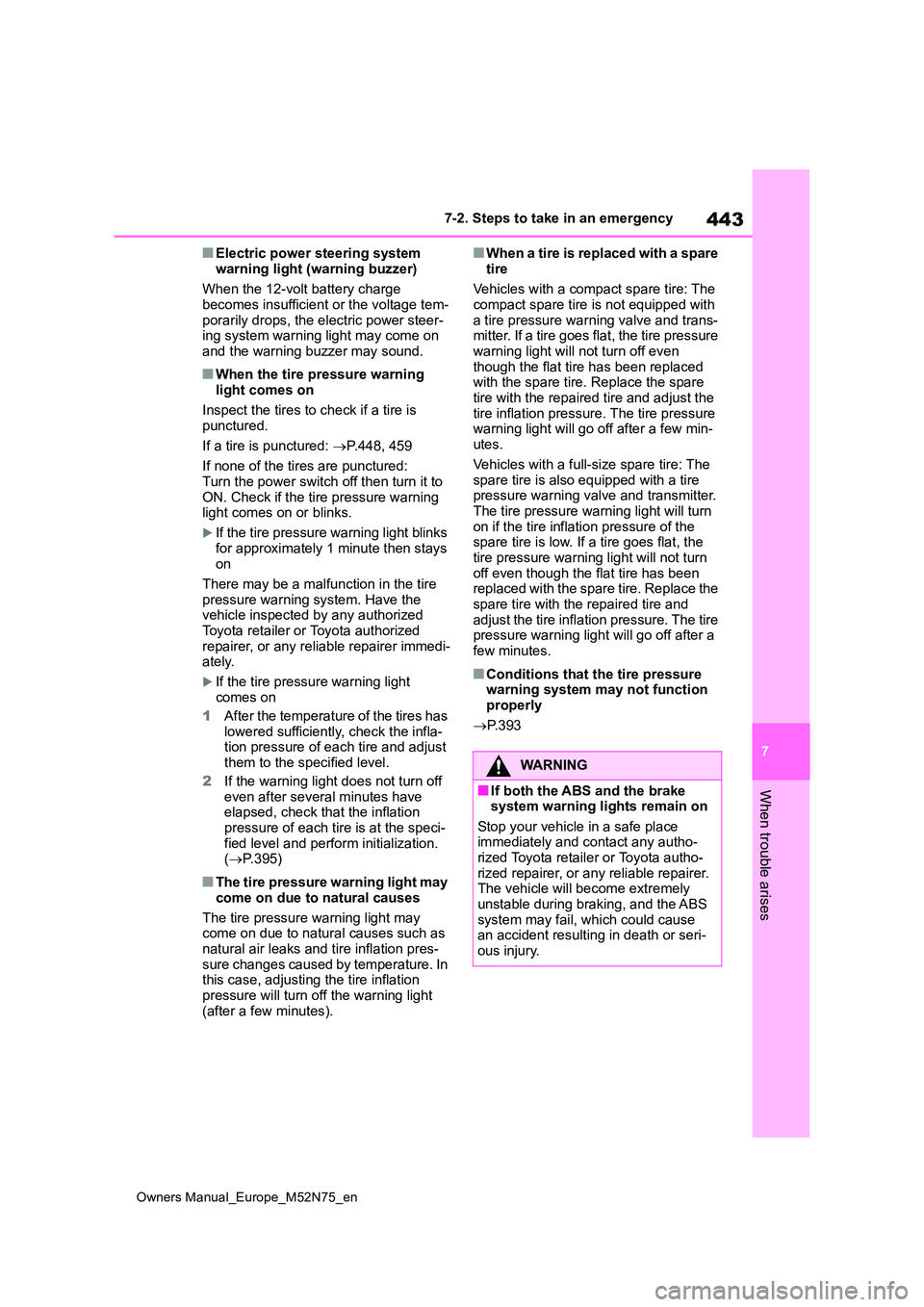
443
7
Owners Manual_Europe_M52N75_en
7-2. Steps to take in an emergency
When trouble arises
■Electric power steering system
warning light (warning buzzer)
When the 12-volt battery charge becomes insufficient or the voltage tem-
porarily drops, the electric power steer- ing system warning light may come on and the warning buzzer may sound.
■When the tire pressure warning
light comes on
Inspect the tires to check if a tire is punctured.
If a tire is punctured: P.448, 459
If none of the tires are punctured: Turn the power switch off then turn it to
ON. Check if the tire pressure warning light comes on or blinks.
If the tire pressure warning light blinks
for approximately 1 minute then stays on
There may be a malfunction in the tire
pressure warning system. Have the vehicle inspected by any authorized Toyota retailer or Toyota authorized
repairer, or any reliable repairer immedi- ately.
If the tire pressure warning light
comes on
1 After the temperature of the tires has lowered sufficiently, check the infla-tion pressure of each tire and adjust
them to the specified level.
2 If the warning light does not turn off even after several minutes have elapsed, check that the inflation
pressure of each tire is at the speci- fied level and perform initialization. ( P.395)
■The tire pressure warning light may
come on due to natural causes
The tire pressure warning light may come on due to natural causes such as
natural air leaks and tire inflation pres- sure changes caused by temperature. In this case, adjusting the tire inflation
pressure will turn off the warning light (after a few minutes).
■When a tire is replaced with a spare
tire
Vehicles with a compact spare tire: The compact spare tire is not equipped with
a tire pressure warning valve and trans- mitter. If a tire goes flat, the tire pressure warning light will not turn off even
though the flat tire has been replaced with the spare tire. Replace the spare tire with the repaired tire and adjust the
tire inflation pressure. The tire pressure warning light will go off after a few min-utes.
Vehicles with a full-size spare tire: The spare tire is also equipped with a tire pressure warning valve and transmitter.
The tire pressure warning light will turn on if the tire inflation pressure of the spare tire is low. If a tire goes flat, the
tire pressure warning light will not turn off even though the flat tire has been replaced with the spare tire. Replace the
spare tire with the repaired tire and adjust the tire inflation pressure. The tire pressure warning light will go off after a
few minutes.
■Conditions that the tire pressure warning system may not function properly
P. 3 9 3
WARNING
■If both the ABS and the brake system warning lights remain on
Stop your vehicle in a safe place immediately and contact any autho-rized Toyota retailer or Toyota autho-
rized repairer, or any reliable repairer. The vehicle will become extremely unstable during braking, and the ABS
system may fail, which could cause an accident resulting in death or seri-ous injury.
Page 446 of 698
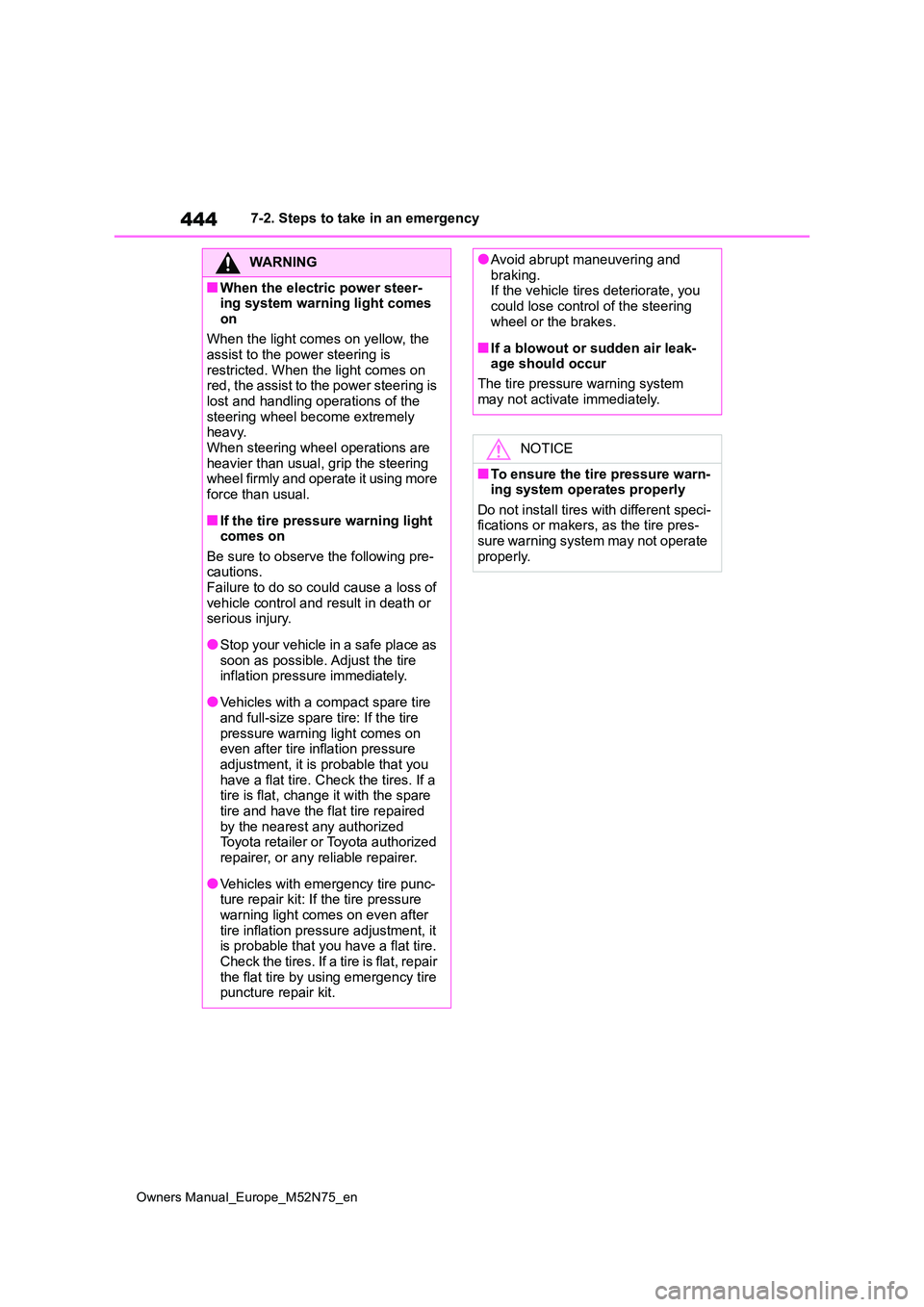
444
Owners Manual_Europe_M52N75_en
7-2. Steps to take in an emergency
WARNING
■When the electric power steer- ing system warning light comes
on
When the light comes on yellow, the assist to the power steering is
restricted. When the light comes on red, the assist to the power steering is lost and handling operations of the
steering wheel become extremely heavy.When steering wheel operations are
heavier than usual, grip the steering wheel firmly and operate it using more force than usual.
■If the tire pressure warning light comes on
Be sure to observe the following pre- cautions.Failure to do so could cause a loss of
vehicle control and result in death or serious injury.
●Stop your vehicle in a safe place as soon as possible. Adjust the tire inflation pressure immediately.
●Vehicles with a compact spare tire and full-size spare tire: If the tire
pressure warning light comes on even after tire inflation pressure adjustment, it is probable that you
have a flat tire. Check the tires. If a tire is flat, change it with the spare tire and have the flat tire repaired
by the nearest any authorized Toyota retailer or Toyota authorized repairer, or any reliable repairer.
●Vehicles with emergency tire punc-ture repair kit: If the tire pressure
warning light comes on even after tire inflation pressure adjustment, it is probable that you have a flat tire.
Check the tires. If a tire is flat, repair the flat tire by using emergency tire puncture repair kit.
●Avoid abrupt maneuvering and braking.If the vehicle tires deteriorate, you
could lose control of the steering wheel or the brakes.
■If a blowout or sudden air leak-age should occur
The tire pressure warning system
may not activate immediately.
NOTICE
■To ensure the tire pressure warn- ing system operates properly
Do not install tires with different speci- fications or makers, as the tire pres-sure warning system may not operate
properly.
Page 451 of 698
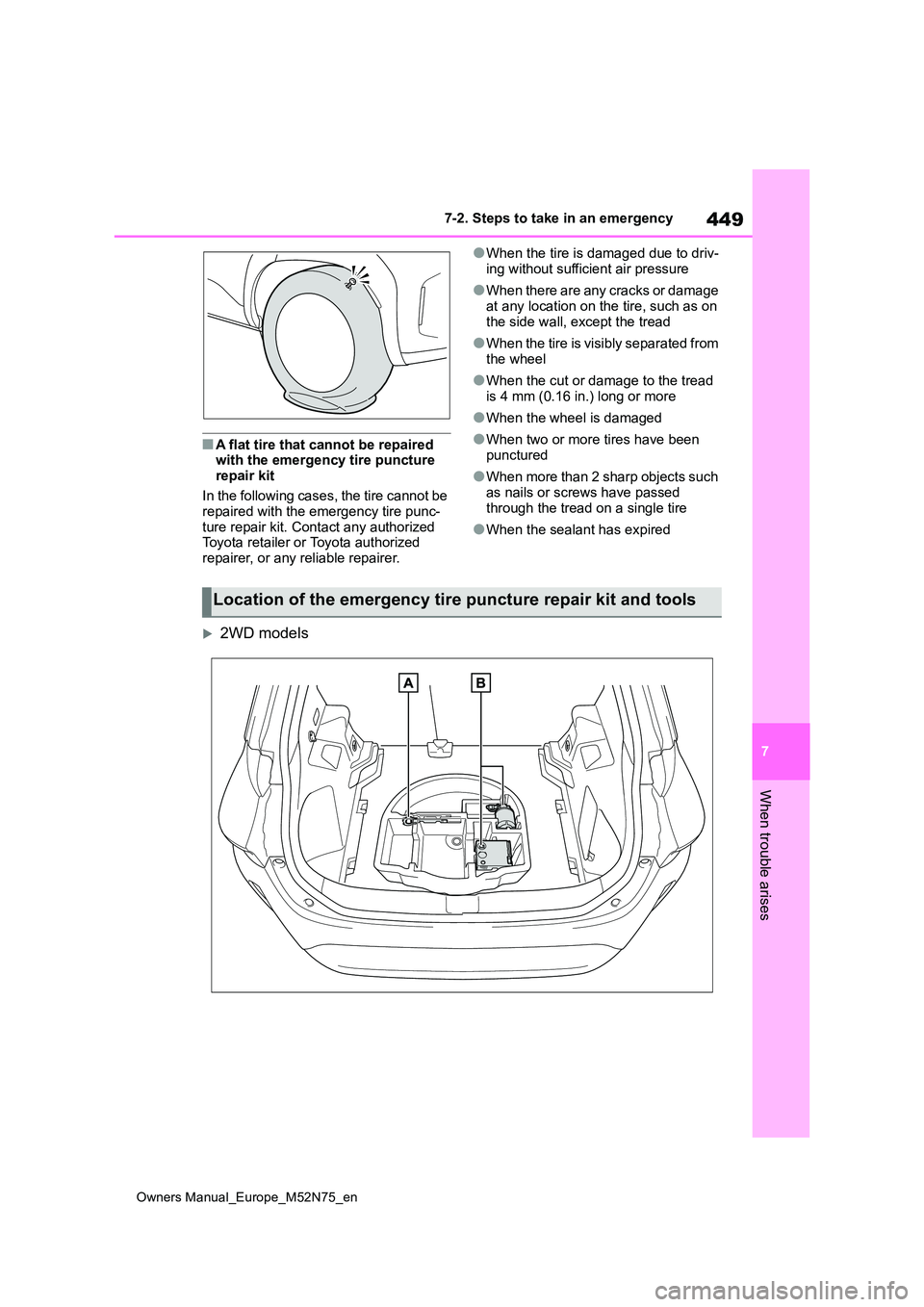
449
7
Owners Manual_Europe_M52N75_en
7-2. Steps to take in an emergency
When trouble arises
■A flat tire that cannot be repaired with the emergency tire puncture
repair kit
In the following cases, the tire cannot be repaired with the emergency tire punc-
ture repair kit. Contact any authorized Toyota retailer or Toyota authorized repairer, or any reliable repairer.
●When the tire is damaged due to driv-
ing without sufficient air pressure
●Wh e n t he r e a r e an y cr a ck s or da ma g e
at any location on the tire, such as on the side wall, except the tread
●When the tire is visibly separated from the wheel
●When the cut or damage to the tread is 4 mm (0.16 in.) long or more
●When the wheel is damaged
●When two or more tires have been
punctured
●When more than 2 sharp objects such
as nails or screws have passed through the tread on a single tire
●When the sealant has expired
2WD models
Location of the emergency tire puncture repair kit and tools
Page 453 of 698

451
7
Owners Manual_Europe_M52N75_en
7-2. Steps to take in an emergency
When trouble arises
Sticker
Hose
Air pressure gauge
Pressure release button
Compressor switch
Power plug
■Note for checking the emergency
tire puncture repair kit
Check the sealant expiry date occasion- ally.
The expiry date is shown on the bottle. Do not use sealant whose expiry date has already passed. Otherwise, repairs
conducted using the emergency tire puncture repair kit may not be per-formed properly.
■Emergency tire puncture repair kit
●The emergency tire puncture repair kit is for filling the car tire with air.
●The sealant has a limited life span. The expiry date is marked on the bot-
tle. The sealant should be replaced before the expiry date. Contact any authorized Toyota retailer or Toyota
authorized repairer, or any reliable repairer for replacement.
●The sealant stored in the emergency tire puncture repair kit can be used only once to temporarily repair a sin-
gle tire. If the sealant has been used and needs to be replaced, purchase a new bottle at any authorized Toyota
retailer or Toyota authorized repairer, or any reliable repairer. The compres-sor is reusable.
●The sealant can be used when the outside temperature is from -30°C (-
22°F) to 60°C (140°F).
●The kit is exclusively designed for size
and type of tires originally installed on yo u r ve hi cl e . Do n ot u se it f o r ti r e s t ha t a different size than the original ones,
or for any other purposes.
●If the sealant gets on your clothes, it may stain.
●If the sealant adheres to a wheel or the surface of the vehicle body, the
stain may not be removable if it is not cleaned at once. Immediately wipe away the sealant with a wet cloth.
●During operation of the repair kit, a loud operation noise is produced. This
does not indicate a malfunction.
●Do not use to check or to adjust the
tire pressure.
WARNING
■Caution while driving
●Store the repair kit in the luggage
compartment. Injuries may result in the event of an accident or sudden braking.
●The repair kit is exclusively only for your vehicle.
Do not use repair kit on other vehi- cles, which could lead to an acci-dent causing death or serious
injury.
●Do not use repair kit for tires that
are different size than the original ones, or for any other purpose. If the tires have not been completely
repaired, it could lead to an acci- dent causing death or serious injury.
■Precautions for use of the seal-ant
●Ingesting the sealant is hazardous to your health. If you ingest sealant, consume as much water as possi-
ble, and then immediately consult a doctor.
●If sealant gets in eyes or adheres to skin, immediately wash it off with water. If discomfort persists, consult
a doctor.
Page 456 of 698
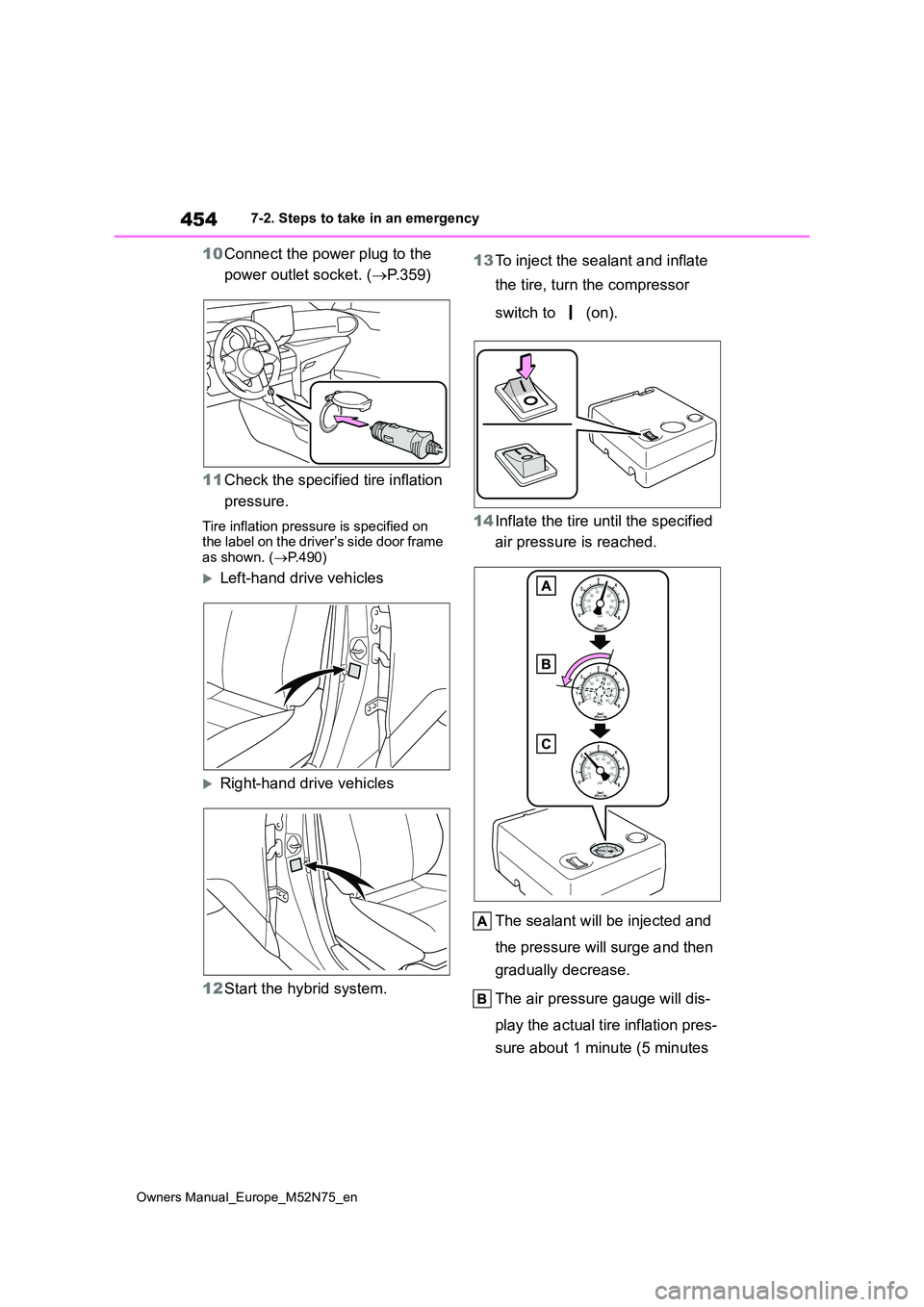
454
Owners Manual_Europe_M52N75_en
7-2. Steps to take in an emergency
10Connect the power plug to the
power outlet socket. ( P.359)
11 Check the specified tire inflation
pressure.
Tire inflation pressure is specified on the label on the driver’s side door frame as shown. ( P.490)
Left-hand drive vehicles
Right-hand drive vehicles
12 Start the hybrid system.
13 To inject the sealant and inflate
the tire, turn the compressor
switch to (on).
14 Inflate the tire until the specified
air pressure is reached.
The sealant will be injected and
the pressure will surge and then
gradually decrease.
The air pressure gauge will dis-
play the actual tire inflation pres-
sure about 1 minute (5 minutes
Page 457 of 698

455
7
Owners Manual_Europe_M52N75_en
7-2. Steps to take in an emergency
When trouble arises
at low temperature) after the
switch is turned (on).
Inflate the tire to the specified air
pressure.
If the tire inflation pressure is still
lower than the specified point
after inflation for 35 minutes with
the switch at (on), the tire is
too damaged to be repaired.
Turn the compressor switch to
(off) and contact any autho-
rized Toyota retailer or Toyota
authorized repairer, or any reli-
able repairer.
If the tire inflation pressure
exceeds the specified air pres-
sure, let out some air to adjust
the tire inflation pressure.
( P.457, 490)
15 Turn the compressor switch to
(off)
16 Disconnect the nozzle from the
valve on the tire and then pull
out the power plug from the
power outlet socket or cigarette
lighter.
Some sealant may leak when the noz-
zle is removed.
17 Press the button to release
pressure from the bottle.
18 Attach the cap to the nozzle.
19 Install the valve cap onto the
valve of the emergency repaired
tire.
20 Disconnect the hose from the
bottle and attach the cap to the
bottle.
Place the bottle in the original bag and zip it.
Page 458 of 698
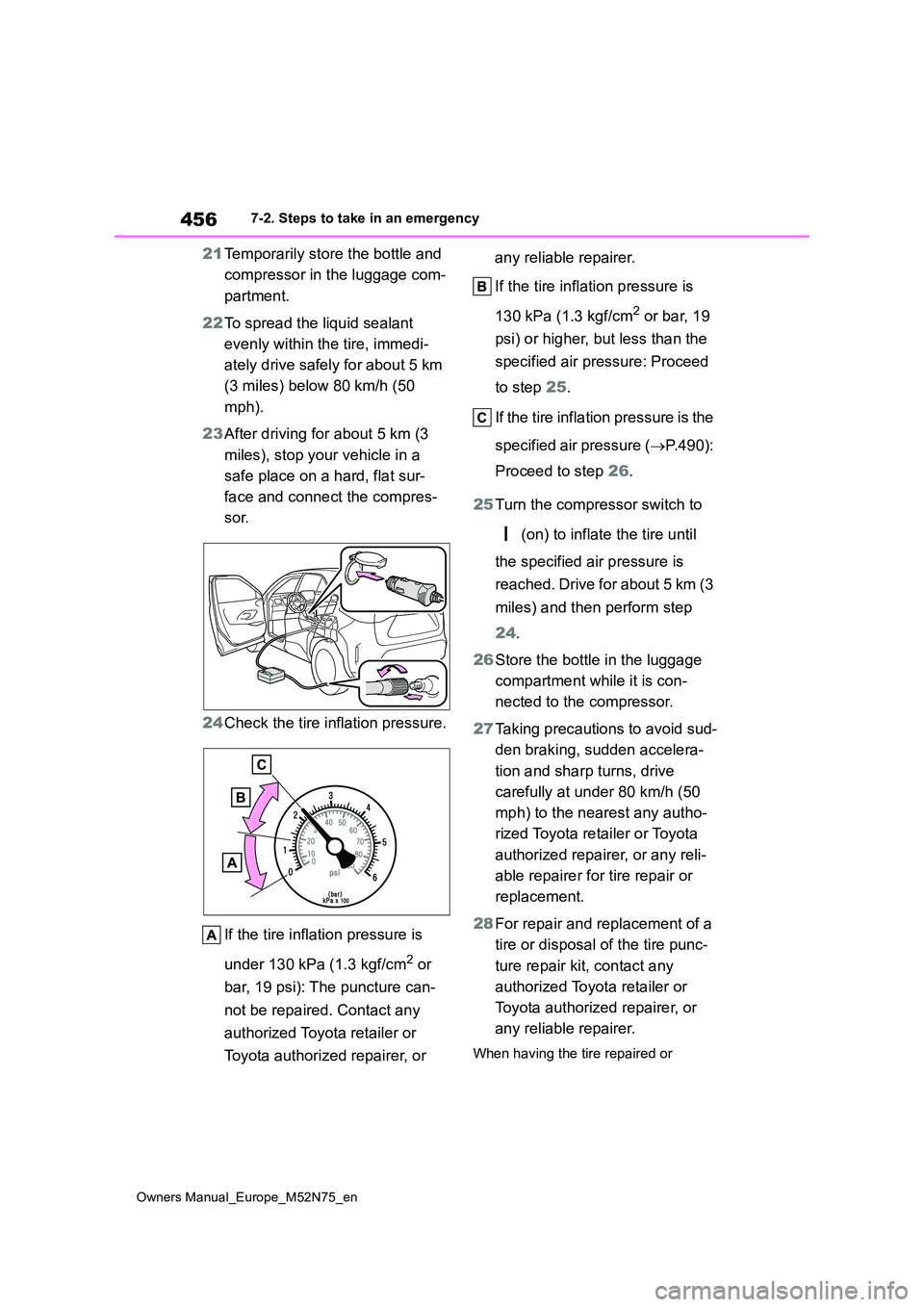
456
Owners Manual_Europe_M52N75_en
7-2. Steps to take in an emergency
21Temporarily store the bottle and
compressor in the luggage com-
partment.
22 To spread the liquid sealant
evenly within the tire, immedi-
ately drive safely for about 5 km
(3 miles) below 80 km/h (50
mph).
23 After driving for about 5 km (3
miles), stop your vehicle in a
safe place on a hard, flat sur-
face and connect the compres-
sor.
24 Check the tire inflation pressure.
If the tire inflation pressure is
under 130 kPa (1.3 kgf/cm2 or
bar, 19 psi): The puncture can-
not be repaired. Contact any
authorized Toyota retailer or
Toyota authorized repairer, or
any reliable repairer.
If the tire inflation pressure is
130 kPa (1.3 kgf/cm2 or bar, 19
psi) or higher, but less than the
specified air pressure: Proceed
to step 25.
If the tire inflation pressure is the
specified air pressure ( P.490):
Proceed to step 26.
25 Turn the compressor switch to
(on) to inflate the tire until
the specified air pressure is
reached. Drive for about 5 km (3
miles) and then perform step
24 .
26 Store the bottle in the luggage
compartment while it is con-
nected to the compressor.
27 Taking precautions to avoid sud-
den braking, sudden accelera-
tion and sharp turns, drive
carefully at under 80 km/h (50
mph) to the nearest any autho-
rized Toyota retailer or Toyota
authorized repairer, or any reli-
able repairer for tire repair or
replacement.
28 For repair and replacement of a
tire or disposal of the tire punc-
ture repair kit, contact any
authorized Toyota retailer or
Toyota authorized repairer, or
any reliable repairer.
When having the tire repaired or